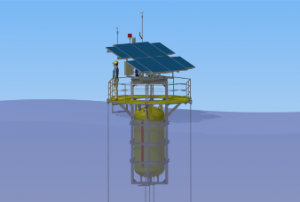Running between July 2016 and June 2019, project ‘FLASC’ is looking at ways of creating and storing unused offshore renewable energy. Here, the team behind the project explains the concept and what it hopes to achieve.

Prof Tonio Sant, Dr Ing Robert Farrugia, Dr Ing Daniel Buhagiar
Imagine having a job that gave you a great salary, but, instead of taking that money and depositing it in a bank for a rainy day, you simply took how much you needed on that particular day and threw the rest away… Sounds crazy, right? Well, that’s what happens to a lot of renewable energy.
Now, a new project pioneering under the name ‘FLASC’, which stands for Floating Liquid-piston Accumulator using Seawater under Compression, is looking to change that.
“People underestimate the importance of storage,” explains Dr Ing Robert Farrugia from the Institute for Sustainable Energy within the University of Malta (UoM). “Renewable resources such as the sun and wind are intermittent and so renewable energy systems only produce electrical energy when the wind blows or the sun shines. In situations when there is no demand from consumers, the renewable energy will possibly be wasted.”
That, of course, is quite the shame, particularly when considering that demand and supply are rarely proportionate or well-timed, and especially when that energy could be deployed onto a grid to be used when needed.
“Moreover, when it comes to energy management, not having control of the supply can be very problematic,” adds Dr Ing Daniel Buhagiar, a post-doc researcher in Mechanical Engineering, who is also working on FLASC. “We need to start thinking of schedulable renewable energy supply in the same way as conventional power stations based on fossil fuels.”
The intermittency of these fluctuating and unpredictable energy sources used to generate renewable energy is what FLASC has been created to hopefully solve. And the hydro-pneumatic energy storage system created to do so is currently being considered for integration into an offshore floating platform. A scaled proof of concept prototype will be tested in Malta’s Grand Harbour. What’s particularly special about it, however, is its unique design and function.

FLASC Prototype
“Through its dual-chamber approach, FLASC solves one of the key challenges of taking this approach to store unused offshore renewable energy, which is managing the wide pressure and temperature changes taking place during the charging and discharging cycles,” explains Professor Tonio Sant, who oversaw the PhD research by Dr Ing Buhagiar who came up with the concept. “What does this mean? It means that when offshore renewable energy systems [such as wind turbines, wave systems, floating PV panels, etc.] generate more energy than needed, the surplus is then used to pump sea water into a compressed air chamber, with the stored energy to be used when needed by releasing the pressurised sea water through a turbine.”
Over the span of 18 months, the team of researchers – with the help of partner MedServ plc. – will be monitoring a Compressed Air Energy Storage System (CAES) and assessing how it changes at various times of the year and in different weather conditions. In the long-run, however, FLASC could be integrated into grid-connected or off-grid offshore systems and could even be used to store pressurized, cold, deep seawater to be used in liquefied natural gas (LNG) liquefaction and enhanced oil recovery processes at sea.
Running for a total of three years, this Malta Council for Science and Technology (MCST)-funded project is expected to cost over €230,000, but that is nothing compared to the future potential that FLASC has. In fact, FLASC could revolutionise the way everything from floating airports (such as Tokyo Bay in Japan) to luxury islands all across the world store energy!
“Our main competitor at the moment is batteries,” adds Dr Ing Buhagiar, “so one of the things we need to look at is how much energy can be stored. FLASC feasibility is now being studied for a six-megawatt wind turbine with a rotor diameter of 126 metres but, in the future, one could even consider a system for a 10-megawatt wind turbine that could nearly double the amount of energy stored! Of course, we’re also hoping to commercialise this but we know that investors don’t just look at a technology within a vacuum: the price needs to be right.”
Notwithstanding the commercial potential of FLASC, the project is also an important one environmentally-speaking; particularly for a country like Malta that is surrounded by the sea offering enormous potential for clean energy generation from the wind and sun. And it is for this reason that the Research Innovation Development Trust (RIDT) proudly donated the funding needed to develop a system that monitors the temperature variations of the pressure vessel surfaces of the FLASC prototype.
Where it will go and what the final outcome will be is anyone’s guess for the time being, what’s certain is that the possibilities are huge!
Help us fund more projects like this, as well as research in all the faculties, by donating to RIDT. Click here for more information on how to donate.
